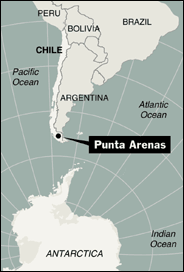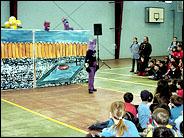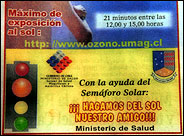|
| Punta Arenas |

|
| The planet's most southern city, needs sunblock. |
In an Upside-Down World, Sunshine Is Shunned
By LARRY ROHTER
UNTA
ARENAS, Chile Everything is different here at the bottom of the world, starting with the weather. Before Alejandra Mundaca
lets her two children go out, she checks the forecast for the temperature, chances of rain and also the level of ultraviolet
rays.
For the last decade the hole in the ozone layer over Antarctica has been forming earlier in
the Southern Hemisphere spring and growing larger. The 125,000 residents of the southernmost city on the planet, here on the
Strait of Magellan, have reluctantly learned to adapt.
They closely watch the color-coded warnings of a "solar stoplight" publicized on television
and radio and even posted on street corners here. Even on warm days, most people insist on wearing jackets or long-sleeved
shirts or blouses. Many wear sunglasses and make sure to apply 50-proof sunblock even when the sky is blanketed in clouds.
"Life has changed a lot for us over the past few years, and I know that my sons are not going
to be able to enjoy the same kind of childhood that I had growing up here," said Ms. Mundaca, 33, a schoolteacher. "We used
to look forward to spring as relief from the long harsh winter, but now it is a time of maximum peril for all of us who live
here."
The ozone layer is a thin covering of gas in the stratosphere that absorbs most of the sun's
ultraviolet rays. Since scientists first discovered the hole over Antarctica in the mid-1980's, it has nearly doubled in size
and now covers an area larger than North America during the Southern Hemisphere spring. The arms of the hole occasionally
extend as far as southern Chile and Argentina, depending on wind patterns.
On a typical day here this month, the solar stoplight was set at orange, the second highest
of four levels, and people were warned to limit their exposure to the sun between noon and 3 p.m. to 21 minutes at most.
"When the light is red, I don't let my kids go out to play at all," Liliana Navarro Torres
said, referring to Kimberley, 6, and Jonathan, 4. "They don't like it much, and sometimes it drives me crazy to have them
running around the house, but that's the way it has to be when you live here."
The growth of the ozone hole is attributed largely to chlorofluorocarbons, or CFC's, that were
widely used in aerosol sprays and refrigerants until an agreement in 1987 to phase them out. But scientists also think that
global warming may be contributing to the phenomenon.
During much of the 1990's there was resistance here to accepting signs that the risks to people
were growing. The warnings of scientists like Bedrich Magas of Magallanes University, one of the first to emphasize the potential
dangers, were dismissed by local boosters who feared a drop in tourism.
But that changed in September 2000, when the ozone hole opened directly over Punta Arenas.
The Socialist government responded with a far-reaching prevention and education program that has become visible everywhere.
"It's a new way of living," said Lidia Amarales Osorno, the Chilean Health Ministry's regional
director here. "You'll see the solar stoplight posted in supermarkets, offices and schools, and we even have an Ozone Brigade
to raise consciousness about this problem."
| Children are taught how to protect |

|
| themselves against ultraviolet rays. |
In elementary schools, a giant penguin named Paul leads a permanent campaign to teach children
the steps they need to take to protect themselves. Many schools also hoist a flag each morning to alert their pupils' families
of the expected level of ultraviolet rays, and in some poor neighborhoods, skin creams are even distributed free to youngsters.
"But the truth is that there is only so much that we can do here ourselves," Dr. Amarales said.
This year, to everyone's bafflement, the situation has been relatively mild. The ozone hole
split in two for only the second time since monitoring began, with only the smaller part passing over Punta Arenas, winds
have been calmer than usual, and the hole has begun to retract earlier than usual.
But scientists here warn that the problem may persist until the middle of the century and is
likely to worsen through the decade.
The laboratory here has also reported the appearance of smaller ozone holes in central Chile,
and health officials say that the incidence of melanoma, the most common form of skin cancer, in Santiago, the country's capital,
increased by 105 percent between 1992 and 1998.
Because solar radiation reaches the ground at a more acute angle here than places farther north,
Punta Arenas may actually be at less risk than other parts of Chile.
But this time of year, atmospheric scientists from all over the world flock here anyway, drawn
by the opportunity to study a rare and little-understood phenomenon. Their presence, rather than reassuring residents, only
adds to their sense of unease.
"We feel like we are rabbits in a laboratory experiment," said Ivan Mansilla Vera, 36, an engineer
and father of two young children. "Nobody knows what is going to happen to us."
| A SOLAR STOPLIGHT, WITH FOUR WARNING LEVELS |

|
| EACH LEVEL LIMITS THE AMOUNT OF EXPOSURE TO THE SUN. |
|

